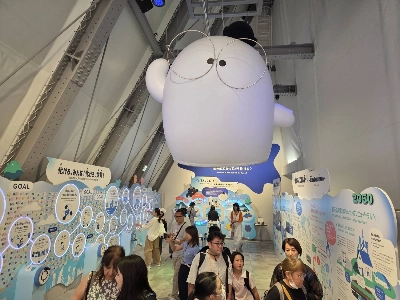In February, Italian researchers announced what they claimed to be a world-first discovery: microplastic particles were found in the ovarian follicular fluid of women undergoing infertility treatment.
The study adds to a growing body of research from around the world showing that tiny plastic particles have made their way into nearly every part of our body, from hair, saliva and blood to breast milk, the liver, kidneys and even the placenta.
The research, published in the Ecotoxicology and Environmental Safety journal, warned of an “emerging threat to female fertility” and called for “further investigations to explore the possible damages that these microparticles can cause in terms of human reproduction and female fertility.”
Japan, whose population is rapidly graying and dwindling, is no stranger to infertility. In 2021, 1 in 4.4 couples in the country said they had been tested or treated for conception problems, up from 1 in 8 in 2002.
Could there be a worrisome connection?
Experts say that more rigorous research is needed before saying that microplastics are linked to the infertility crisis. Still, scientists broadly agree that it’s time for government regulators and citizens alike to rethink the approach toward plastic in order to protect our health.
Hideshige Takada is one scientist who has been sounding the alarm. A professor emeritus at the Tokyo University of Agriculture and Technology and a pioneer in microplastics pollution research, he’s particularly concerned about the effects of chemicals added to plastics.
“Compared with 10 years ago, we know much more about the harmful effects of microplastics,” he says. “There’s been growing evidence that many of the chemicals added to plastics to maintain or improve their functions ... are impacting human health.”
Plastic pollution
Plastic is part of the fabric of everyday life, from bags to bottles to synthetic clothing. And despite efforts by some countries, we keep producing more. In 2023, global production stood at 414 million tons, up from 311 million tons in 2014 and 225 million tons in 2004, according to the manufacturers group Plastics Europe.
Plastic waste now litters the Earth, with much of it ending up in the oceans in the form of tiny fragments, or microplastics. Microplastics absorb toxic chemicals, get ingested by marine animals and climb back through the food chain.
Microplastics are defined as plastic particles less than 5 millimeters in diameter, while nanoplastics are even smaller particles of less than 1 micrometer. They are produced from plastics that we use in daily life, either through litter or through products that fall through the recycling system, such as plastic waste that blows out of trash bins and winds up in rivers or oceans.
When exposed to ultraviolet rays in strong sunlight, plastics decay and break into small pieces. These tiny particles are more easily carried offshore and accumulate in oceans. Synthetic clothes also shed microfibers, which are flushed from washing machines into wastewater, and into streams, rivers and oceans.
Today, microplastics are everywhere in the environment, and as a result, we eat, drink and breathe them regularly.
Endocrine-disrupting chemicals
While there is some research saying microplastics themselves damage our body physically by causing inflammation, Takada says it is really the chemicals that do the most harm.
Plastics contain a host of additives to keep them from degrading, such as antioxidants and UV absorbers. Also, they contain chemicals to add flexibility and prevent them from catching fire.
Many of these chemicals have structures similar to female hormones, and they bind to hormone receptors in the cells when they enter the body, sending the wrong signals. They are known to act as endocrine disruptors, or “environmental hormones.”
“Female hormones regulate sexual functions, reproduction and brain development, and that’s why these chemicals are believed to cause problems in such functions,” Takada says.
“We now know how these additives cause reproductive abnormalities, and we have over 1,000 studies saying additives have been found in the body. All things considered, I feel there’s no room to doubt that plastic additives or monomers (the smallest unit of plastics) produced as a result of plastic breakdown affect human health.”
Phthalates and bisphenol A are among the chemicals commonly used in plastics and are known to disrupt hormone functions. PFAS, also known as “forever chemicals” because of their extreme persistence in the environment, are another group of substances that are commonly found in plastic products and are linked to a wide range of health issues, including cancer.
Currently, the health ministry regulates some of the phthalates in children’s toys and food containers and packaging, and sets maximum amounts for bisphenol A that can be transferred into food. Such regulations are effective in keeping the “direct” exposure to harmful chemicals at bay, but not enough to prevent the “indirect” exposure, through the fish we consume, the air we breathe or the water we drink, Takada argues.
And regulations on specific chemicals fall short, he says. He cites a 2023 United Nations Environment Program report on chemicals in plastics, which states that over 3,200 chemicals detected in plastics have “one or more hazardous properties of concern,” including ones that can “mimic, block or alter the actions of hormones, reduce fertility, damage the nervous system, and/or cause cancer.”
At present, only 130 of the 3,200 chemicals are regulated by international or regional treaties, according to Takada.
Takada acknowledges issues raised regarding the quality of research. For example, the equipment researchers use to collect samples is rife with risks of plastic contamination. Also, there are chemicals in the human body that are very similar to plastics. Researchers may confuse the two, which could lead to the detection of unreasonably high levels of microplastics in the body, he says.
In March, scientists at Irish and British institutions pointed to issues surrounding microplastics research in a commentary published by Nature, calling for “more rigorous standards, transparency and collaboration” among researchers, policymakers and industrial stakeholders.
They questioned many of the studies published so far, saying they rely on small sample sizes of typically 20 to 50 individuals. (The February ovarian study found microplastics in 14 of the 18 women checked.)
“Modern laboratories are themselves hotspots of nanoplastic and microplastic pollution, and the approaches that are being used to detect plastics make it hard to rule out the possibility of contamination, or prove definitively that plastics are in a sample,” they wrote.
Male infertility
The decline of semen quality, including a decrease in sperm counts and their swimming ability, has long been documented, with some researchers calling for more investigations into its link with Japan’s falling birthrate.
Soichiro Ogawa, associate professor of urology at the Fukushima Medical University’s School of Medicine, sees many male patients with fertility issues. Based on the available evidence, however, the effects of microplastics or particular chemicals on male infertility remain unknown, he says.
“We can’t draw conclusions from just one or two studies,” he says. “There are so many studies out there, and even peer-reviewed ones are of mixed quality.”
In addition to microplastics and toxic chemicals, many other environmental factors have been studied for their potential links to male infertility, ranging from heat, radiation, electromagnetic waves, pesticides and air pollution. Of all these, smoking poses the biggest risk, Ogawa says, noting that he recommends patients stop smoking to protect their health as well as their family’s.
Takada argues there are limits to the evidence-based approach toward individual chemical substances. Modern plastic pollution is very different from 20th-century chemical pollution like the mercury poisoning that caused Minamata disease, where concentrations of specific chemicals were very high and it was relatively easy to identify the cause of the problem, he says.
“In the 21st century, we are dealing with numerous chemical substances or multiple factors that, on their own, may not have a health effect, but when combined, can cause harm,” Takada says. “We're now in an era where it's increasingly difficult to pinpoint a single substance or phenomenon as the cause of a problem.”
As such, reducing production and consumption of plastics as a whole, instead of regulating individual substances, is most effective to minimize exposure and risks of chemicals to humans, he argues.
Policy changes
Late last year, the 5th session of the U.N. Intergovernmental Negotiating Committee on plastic pollution (INC-5) was held in Busan, South Korea. But at the session, which was meant to be the last one, negotiators failed to reach a legally binding treaty to curb plastic pollution. The countries are meeting again in Geneva, Switzerland, in August.
When it comes to policy changes, Japan may be able to learn from Europe, where the “nudge” theory is used effectively, says Keita Nakayama, an environmental law expert and lecturer at Waseda University.
The “nudge,” a concept from behavioral economics, is called the fourth policy approach, after laws, taxes and subsidies. It is a tool to encourage people and businesses to make better decisions without coercing them.
Nakayama cites the case of the European strategy for plastics released by the EU in 2018, which included calling on companies and business groups to make voluntary pledges to use or produce more recycled plastics. He says it worked as a nudge even though the strategy was not legally binding on its own. The same day the strategy was announced, McDonald’s said it would switch all of its packaging to renewable, recycled or certified sources in all restaurants worldwide by the end of 2025. Iceland Foods, a Wales-based supermarket chain famous for its frozen meals, also announced on the same day that it will eliminate plastic packaging from all of its brand products by 2023.
Behind such corporate moves were advance coordination with businesses by authorities, which worked as a “nudge,” Nakayama says.
Japan introduced a plastic strategy of its own in 2019 and enforced a law aimed at promoting the resource circulation for plastics in 2022, but it has been criticized by environmental groups as lacking teeth and being too reliant on recycling instead of reducing the use of plastics.
The introduction of a nationwide plastic bag fee for shoppers in July 2020 did work to reduce plastic waste, halving the volume of plastic bags in circulation to 100,000 tons in two years, according to the Environment Ministry. Now, well over 80% of people turn down plastic bags at retail stores, according to the latest statistics from the Japan Chain Stores Association, up from about 55% in 2019.
But plastic shopping bags make up only a fraction of the country’s total plastic waste. Plastic packages and containers — be it cutlery, PET bottles or bento boxes — are still everywhere, accounting for nearly half of the nation’s plastic waste.
Japan has been reluctant to regulate plastic production so far, refusing to join a proposal supported by about 100 countries to set a production reduction target during the INC-5 negotiations.
In addition, while 87% of Japan’s plastic waste was recycled as of 2022, more than two-thirds of that was done through thermal recycling, which emits carbon dioxide and contributes to global warming.
So what should individuals do to reduce health risks?
Takada says separating plastic from our food is key. Plastics degrade with heat, so avoiding reheating ready-made food in plastic containers and switching to glass instead of plastic for food storage is a good starting point, he says. PET bottles could also contain harmful chemicals in their caps, he adds.
“It’s impossible to eliminate all sources of chemicals associated with plastics, but it would be helpful to reduce their use wherever possible,” he says. “They don’t stay long in the body, so reducing your daily exposure lowers your long-term risks.”




























With your current subscription plan you can comment on stories. However, before writing your first comment, please create a display name in the Profile section of your subscriber account page.